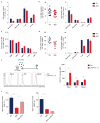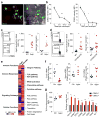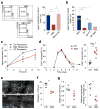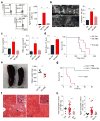Neutrophil ageing is regulated by the microbiome
- PMID: 26374999
- PMCID: PMC4712631
- DOI: 10.1038/nature15367
Neutrophil ageing is regulated by the microbiome
Abstract
Blood polymorphonuclear neutrophils provide immune protection against pathogens, but may also promote tissue injury in inflammatory diseases. Although neutrophils are generally considered to be a relatively homogeneous population, evidence for heterogeneity is emerging. Under steady-state conditions, neutrophil heterogeneity may arise from ageing and replenishment by newly released neutrophils from the bone marrow. Aged neutrophils upregulate CXCR4, a receptor allowing their clearance in the bone marrow, with feedback inhibition of neutrophil production via the IL-17/G-CSF axis, and rhythmic modulation of the haematopoietic stem-cell niche. The aged subset also expresses low levels of L-selectin. Previous studies have suggested that in vitro-aged neutrophils exhibit impaired migration and reduced pro-inflammatory properties. Here, using in vivo ageing analyses in mice, we show that neutrophil pro-inflammatory activity correlates positively with their ageing whilst in circulation. Aged neutrophils represent an overly active subset exhibiting enhanced αMβ2 integrin activation and neutrophil extracellular trap formation under inflammatory conditions. Neutrophil ageing is driven by the microbiota via Toll-like receptor and myeloid differentiation factor 88-mediated signalling pathways. Depletion of the microbiota significantly reduces the number of circulating aged neutrophils and dramatically improves the pathogenesis and inflammation-related organ damage in models of sickle-cell disease or endotoxin-induced septic shock. These results identify a role for the microbiota in regulating a disease-promoting neutrophil subset.
Conflict of interest statement
The authors declare no competing financial interests.
Figures












Comment in
-
Neutrophils: Growing old disgracefully?Nat Rev Immunol. 2015 Nov;15(11):665. doi: 10.1038/nri3924. Epub 2015 Oct 16. Nat Rev Immunol. 2015. PMID: 26471779 No abstract available.
References
-
- Nauseef WM, Borregaard N. Neutrophils at work. Nature immunology. 2014;15:602–611. - PubMed
Publication types
MeSH terms
Substances
Associated data
- Actions
Grants and funding
LinkOut - more resources
Full Text Sources
Other Literature Sources
Molecular Biology Databases

